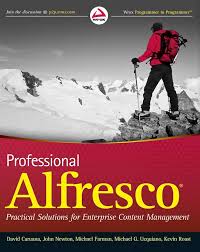White Paper: Mastering Alfresco: A Comprehensive Guide to Digital Experience Platforms
Abstract
Alfresco, a leading open-source digital experience platform (DXP), empowers organizations to manage, share, and collaborate on content. This white paper, inspired by David Charuana's "Professional Alfresco," delves into the core concepts, features, and best practices for leveraging Alfresco to build robust and scalable content management solutions. We'll explore its application in various domains, such as enterprise content management, digital asset management, and business process management.
Introduction
Alfresco's flexibility and extensibility make it a popular choice for organizations seeking to manage and share content efficiently. This white paper aims to provide a comprehensive overview of Alfresco's key features, best practices, and real-world applications. By understanding the fundamentals of Alfresco and its ecosystem, you can effectively harness its power to create innovative and engaging digital experiences.
Core Concepts of Alfresco
- Content Repositories: Alfresco's core feature for storing and managing content.
- Document Management: Organize, search, and version control documents.
- Records Management: Ensure compliance with retention policies and legal requirements.
- Workflow: Automate business processes and streamline workflows.
- Web Content Management (WCM): Create and manage web content, including pages, articles, and blogs.
- Search: Powerful search capabilities to find information quickly.
- Security: Robust security features to protect sensitive information.
Key Features of Alfresco
- Drag-and-Drop Interface: Easily upload and manage content.
- Version Control: Track changes to documents and restore previous versions.
- Metadata Management: Organize content with metadata tags and categories.
- Collaboration Tools: Facilitate teamwork with features like commenting, sharing, and notifications.
- Mobile Access: Access content on the go with mobile devices.
- Integration Capabilities: Integrate with other systems and applications using APIs and connectors.
Best Practices for Alfresco Development
- Follow Alfresco's Best Practices: Adhere to Liferay's guidelines for development, deployment, and security.
- Leverage Alfresco's Extensibility: Extend Alfresco's functionality with Alfresco Module Development Framework (AMF).
- Utilize Alfresco's Web Scripts: Create custom web applications and services.
- Optimize Performance: Implement caching, indexing, and other performance optimization techniques.
- Secure Your Alfresco Instance: Keep your Alfresco installation up-to-date with the latest security patches.
- Test Thoroughly: Conduct thorough testing to ensure the quality and stability of your Alfresco applications.
Real-World Applications of Alfresco
- Enterprise Content Management (ECM): Centralize and manage corporate documents, records, and knowledge assets.
- Digital Asset Management (DAM): Store, organize, and distribute digital assets like images, videos, and audio files.
- Collaboration Platforms: Facilitate teamwork and knowledge sharing within organizations.
- Web Content Management (WCM): Create and manage websites and web applications.
Conclusion
Alfresco is a powerful and versatile platform for managing digital content and automating business processes. By understanding its core concepts, features, and best practices, you can effectively leverage Alfresco to create innovative and efficient digital solutions.
References
- Charuana, D. (2014). Professional Alfresco. Wrox.
- Alfresco Documentation: https://community.alfresco.com/
By combining the theoretical knowledge from "Professional Alfresco" with hands-on experience and continuous learning, you can become a proficient Alfresco administrator and developer, enabling your organization to harness the power of digital transformation.



